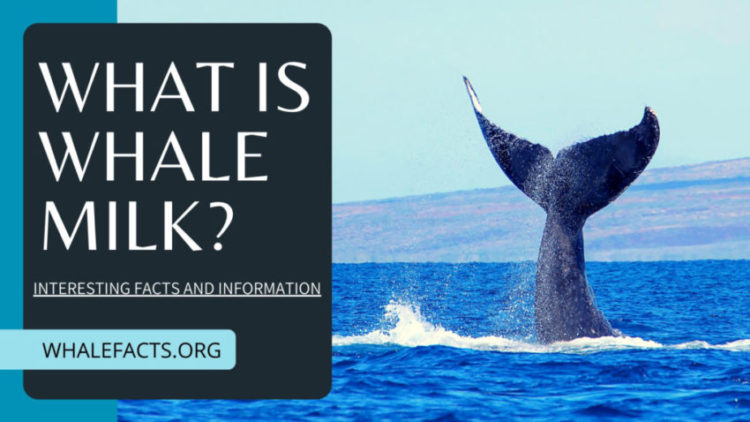Whales are marine mammals, and like all mammals (except for a few species), they share many of the same traits with land mammals, including baring offspring (whales have a gestation period similar that is very similar to pregnancy in humans), being warm-blooded, having hair (some species are born with hair) and producing milk to feed their young.
Shortly after birth, the mother feeds her child milk from her nipple since the child cannot hunt for its own food.
When the female whale lactates, the thickness of the whale’s milk can vary greatly.
In fact, a 35% – 50% fat concentration is common among many species of whale as the higher fat percentage allows the whale’s milk to travel through the water without breaking up.
The thick milk is often referred to as having a toothpaste-like consistency.
This is very important because, for the adult female whale to feed her baby, she must either shoot the milk into her baby’s mouth through the water or allow the child to suckle the milk from her nipple.
If the fat consistency is too low, then the mother’s milk would dissolve in the water, making it difficult for the baby whale to feed and receive adequate nutrients.
The fatty milk also provides the baby with lots of nutrients and energy to help the baby grow into a healthy young adult.
To maximize the baby’s milk transfer, some children may use their tongue to create a tight seal around the mother’s nipple.
A few whale species (such as the blue whale) may drink more than 150 gallons of milk per day and can easily gain 100 pounds or more each day in its first few months of birth, primarily from drinking its mother’s milk.
Baby whales can often consume anywhere from 2% to 10% of their weight in milk daily.
In terms of how long a baby whale may feed on its mother’s milk, the length of nursing can vary greatly, lasting anywhere from 6 months – 2 years, depending on the whale’s species.
Birth, nursing, and relationships
Females may mate with several males during a single season and will typically produce a single offspring (twins are very rare) once every 1 – 5 years, depending on the species.
Producing a single offspring over the course of several years ensures that the newborn will stand a better chance of survival and be given full attention during the first nurturing years of its life.
During the first 6 months to 2 years, the mother will feed her young milk to nourish the baby and provide it with nutrients.
This feeding will go on until the child can hunt for food and survive independently.
In some cases, a child may continue to suckle on the mother’s nipple after they’ve started consuming solid foods and even after the mother stops lactating.
It may take longer for these children to stop suckling due to their psychological dependency on their mother; in most cases, this behavior stops by the age of 2; however, this may last even longer in rare situations.
In addition to feeding their young with milk, mothers often develop very close relationships with their children.
Depending on the species, these relationships may last anywhere from a few years to a lifetime.
In some tightly knit pods or groups, females other than the mother may also care for the mother’s child by protecting the child and, in some cases, even feeding it.
However, this depends largely on the species and the pod.
Within a family group, the male whales are referred to as bulls, females are called cows, and newborns are known as calves.
The importance of milk for healthy growth
As with other animal species (including humans), milk serves an important part in the healthy growth of infant whales and young children.
For baby whales, milk provides high quantities of healthy fats/fatty acids and nutrients that help the child grow, assist with bone development, improve the immune system, and ensures that the child gets the minerals and vitamins it needs for proper physical and brain functioning.
In fact, baby whales may survive solely off milk at the beginning of their birth.
Without milk, these newborns may starve or become malnourished as they no longer receive nutrients from their umbilical cord, which becomes severed at birth.
As stated earlier, baby whales can consume a huge quantity of milk daily, and this milk provides them with the food they need for the first several weeks to the several months of their existence on earth.
Aside from feeding the child, suckling milk can also be thought of as a bonding experience between a mother and her child.
Time and time again, it has been proven that early nourishment and care between a child and his/her parents is essential for proper emotional development, learning basic communication skills.
Smaller marine mammals such as killer whales and other dolphins that have been fed milk from a container (often in captivity) tend to have much shorter and highly stressed lives.
In fact, some estimates state that a killer whale’s lifespan may be reduced by over 50% when held in captivity.
Part of this is due to living in a confined area and being isolated from other animals, and part of it may be due to their diet, such as consuming frozen fish and milk that does not come directly from suckling the mother’s nipples.
As you can see, milk plays an essential part in early child development in providing nutrients and developing a social/emotional bond with its mother.
Even when given the utmost care and compassion, marine mammals (such as dolphins) held in captivity tend to fare less well in lifespan than those who live in the wild.
On the other hand, temporary captivity may be vital to assisting marine mammals in recovering from serious injuries where their chances of surviving in the wild seem fairly low and additional care is required for their development.
